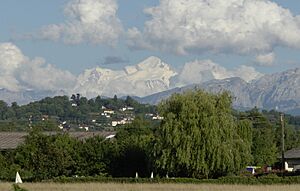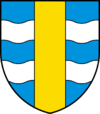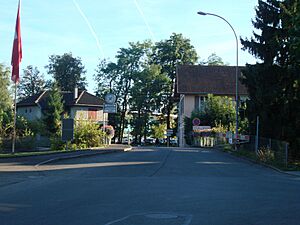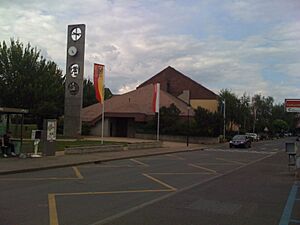Puplinge facts for kids
Quick facts for kids
Puplinge
|
||
|---|---|---|
 |
||
|
||
| Country | Switzerland | |
| Canton | Geneva | |
| District | n.a. | |
| Area | ||
| • Total | 2.67 km2 (1.03 sq mi) | |
| Elevation | 430 m (1,410 ft) | |
| Population
(Dec 2020 )
|
||
| • Total | 2,488 | |
| • Density | 931.8/km2 (2,413/sq mi) | |
| Postal code |
1241
|
|
| Surrounded by | Ambilly (FR-74), Choulex, Presinge, Thônex, Vandœuvres, Ville-la-Grand (FR-74) | |
Puplinge is a small town, also called a municipality, located in the canton of Geneva in Switzerland. It's a quiet place with a mix of history and modern life, close to the French border.
Contents
Discovering Puplinge's Past
The village of Puplinge has a long and interesting history. According to a historian named Pierre Bertrand, the area was settled around the year 443 by a Germanic group called the Burgondes. The name "Puplinge" comes from an old German word, which was later changed to fit the French language. Other nearby villages like Presinge and Merlinge also have names that suggest a strong Germanic influence in the past.
Puplinge was once part of the County of Geneva, which started in the 900s. This area later became part of the Kingdom of Burgundy. Over time, the land changed hands many times. In 1400, it was sold to the Counts of Savoy.
In 1602, when the Duke of Savoy tried to take over Geneva, Puplinge was part of the Savoy territory. It stayed with Savoy until 1659. The first time Puplinge is officially mentioned in records is in 1573.
Before 1860, Puplinge was actually part of a larger French town called Ville-La-Grand. But in 1816, a special agreement called the Treaty of Turin was signed. This treaty led to Puplinge becoming part of Switzerland, along with a neighboring village called Presinge. For a while, Puplinge, Presinge, and some smaller areas were all one municipality.
In 1824, the first school building opened in Puplinge, which was a big step for the community. Later, in 1842, people in the town could vote directly for their local council members for the first time. Because of some disagreements between Puplinge and Presinge, they decided to split into two separate towns in 1850. This created the borders of Puplinge as we know them today.
In 1924, Puplinge got its very own coat of arms, a special symbol representing the town.
Champ-Dollon Prison: A Nearby Landmark
About 1 kilometer (or 0.6 miles) from the village of Puplinge, there is a large building called Champ-Dollon Prison. It is a maximum-security prison and is officially part of the Puplinge municipality. The prison opened in 1977 and was built to hold about 200 people. Today, it can house around 500 people and employs about 200 staff members.
Puplinge's Landscape
Puplinge covers an area of about 2.66 square kilometers (or 1.03 square miles). A large part of this land, about 74.1%, is used for farming. Forests cover about 4.5% of the area. The rest, about 20.7%, is developed with buildings and roads.
Most of the developed land includes homes and other buildings (13.2%) and transportation like roads (5.6%). There are also parks and sports fields, making up 1.5% of the area. The farming land is used for growing crops (59.4%), pastures for animals (6.8%), and orchards or vineyards (7.9%).
Puplinge is located on the left side of the Rhone river. It shares a border with Ville la Grand in France. It also borders other Swiss towns like Choulex, Presinge, and Thônex. The municipality of Puplinge includes smaller areas or villages such as Dardelles, Champ-Dollon, Pesay, and Puplinge village itself.
Who Lives in Puplinge?
| Nationality | Amount | % total (population) |
|---|---|---|
| 107 | 5.2 | |
| 58 | 2.8 | |
| 35 | 1.7 | |
| 21 | 1.0 | |
| 19 | 0.9 | |
| 15 | 0.7 | |
| 13 | 1.6 | |
| 11 | 0.5 | |
| 11 | 0.5 | |
| 7 | 0.3 |

Puplinge has a population of about 2,086 people as of 2008. About 17.2% of the people living in Puplinge are foreign nationals. Over the past ten years (from 1999 to 2009), the population has grown by about 0.9%.
In 2008, about 47.3% of the population was male, and 52.7% was female. Most people in Puplinge were born in Switzerland. About 18.9% were born right in Puplinge, and 30.5% were born in the same canton (Geneva). About 22.8% of the population was born outside of Switzerland.
In 2000, about 25.2% of the population were children and teenagers (0–19 years old). Adults (20–64 years old) made up 66.4%, and seniors (over 64 years old) were 8.4%.
Most people in Puplinge live in private homes. In 2000, there were 820 households, with an average of 2.5 people per home. About 28.3% of homes had only one person living in them.
The historical population of Puplinge has changed over time, as you can see in the chart below:

Languages Spoken in Puplinge
The main language spoken in Puplinge is French. However, a long time ago, before the mid-1600s, another language called Franco-Provençal (also known as Romand in Switzerland) was common in this area. Today, you can only find traces of Franco-Provençal in some street names.
After a treaty in 1540, French became the only official language. This caused the use of other local languages to decline. Modern Switzerland does not recognize Franco-Provençal as an official language.
Some people believe that an ancient language called Ligurian was spoken here even before the Romans arrived. We don't know much about this language, but it's thought to be part of the Indo-European family.
In 2000, most people in Puplinge (83.1%) spoke French. The second most common language was German (4.4%), followed by English (3.3%). A smaller number of people spoke Italian or Romansh.
Puplinge's Economy
Puplinge is mainly a "bedroom community." This means that many residents live in Puplinge but travel to the city of Geneva or other nearby towns for work.
Even though many people commute, farming is still an important part of the local culture. The area has vineyards that grow grapes for making wine at the Chateau Du Crest. There are no large factories or big shopping centers in the village.
In 2010, the unemployment rate in Puplinge was 3.1%. In 2008, there were 34 people working in farming and related businesses. Another 36 people worked in manufacturing and construction. The largest group, 407 people, worked in service jobs like sales, transportation, hotels, or healthcare.
Religion in Puplinge
According to a census in 2000, about 39.1% of the people in Puplinge were Roman Catholic. Another 19.2% belonged to the Swiss Reformed Church.
A small number of people belonged to other Christian churches, including Orthodox and Christian Catholic. There were also small communities of Jewish and Islamic people. A few individuals identified as Buddhist or Hindu. About 22.3% of the population did not belong to any church or identified as agnostic or atheist.
Learning in Puplinge
Education is important in Puplinge. In 2000, about 31.1% of the population had finished high school, and 21.3% had gone on to higher education, like university.
During the 2009–2010 school year, there were 452 students in the Puplinge school system. In Geneva, young children can attend two years of non-required Kindergarten. In Puplinge, 35 children were in pre-kindergarten.
The school system also includes six years of primary school. In Puplinge, 71 students were in kindergarten or primary school. After primary school, students go to secondary school for three required years, followed by three to five years of optional advanced studies. There were 71 students in lower secondary school in Puplinge. Many students from Puplinge also attended schools outside the municipality.
Images for kids
See also
 In Spanish: Puplinge para niños
In Spanish: Puplinge para niños









